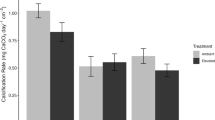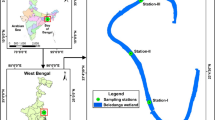Abstract
The macrophyte structure can influence the development of periphytic algal community in a shallow ecosystem. We investigated the interrelationship between periphytic algal community on artificial substrate and macrophyte species richness during four seasons in a tropical shallow reservoir. The periphyton was evaluated by biomass (as AFDM), algal abundance, species composition, and species richness. Limnological variables and macrophyte coverage were determined at sites with different macrophytes richness in littoral zone. Glass slides were used as the substrate and colonization time was 30 days. Periphytic algal structure was significantly influenced by seasonality and macrophyte richness, as well as the interaction of two factors. Periphytic algal density on natural and artificial substrates was negatively correlated with macrophyte richness and coverage. High biomass, algal biovolume and dominance of Zygnemaphyceae occurred when there was an increase of Utricularia foliosa coverage (summer). Our results showed that the seasonality, and to a lesser extent macrophyte species richness, explained significant portion of the variability of periphyton biomass, algal abundance, and taxonomic composition on artificial substrate. The changes in macrophyte community may have direct consequences on the periphyton structure in a shallow tropical reservoir.








Similar content being viewed by others
References
APHA, AWWA & WEF, 2005. Standard Methods for the Examination of Water and Wastewater, 21st ed. American Public Health Association, Washington, DC.
Bicudo, D. C., M. C. Forti & C. E. M. Bicudo, 2002. Parque Estadual das Fontes do Ipiranga (PEFI): unidade de conservação que resiste à urbanização de São Paulo. Secretaria do Meio Ambiente do Estado de São Paulo, São Paulo.
Borduqui, M. & C. Ferragut, 2012. Factors determining periphytic algae succession in a tropical hypereutrophic reservoir. Hydrobiologia 683: 109–122.
Burkholder, J. M., 1996. Interactions of benthic algae with their substrata. In Stevenson, R. J., M. L. Bothwell & R. L. Lowe (eds), Algal Ecology: Freshwater Benthic Ecosystems. Academic Press, San Diego: 253–297.
Camargo, V. M. & C. Ferragut, 2014. Estrutura da comunidade de algas perifíticas em Eleocharis acutangula (Roxb.) Schult (Cyperaceae) em reservatório tropical raso, São Paulo, SP, Brasil. Hoehnea 41(1): 31–40.
Carignan, R. & J. Kalff, 1980. Phosphorus sources for aquatic weeds: water or sediments? Science 207: 987–989.
Cattaneo, A., G. Galanti, S. Gentinetta & S. Romo, 1998. Epiphytic algae and macroinvertebrates on submerged and floating-leaved macrophytes in an Italian lake. Freshwater Biology 39: 725–740.
Cetto, J. M., J. A. Leandrini, S. A. Felisberto & L. Rodrigues, 2004. Comunidade de algas perifíticas no reservatório de Iraí, Estado do Paraná, Brasil. Acta Scientiarum, Biological Sciences 26: 1–7.
Chambers, P. A., P. Lacoul, K. J. Murphy & S. M. Thomaz, 2008. Global diversity of aquatic macrophytes in freshwater. Hydrobiologia 595: 9–26.
Coesel, P. F. M., 2001. A method for quantifying conservation value in lentic freshwater habitats using desmids as indicator organisms. Biodiversity and Conservation 10: 177–187.
Cohn, S. A. & R. E. Weitzell Jr, 1996. Ecological considerations of diatom cell motility. I. Characterization of motility and adhesion in four diatom species. Journal of Phycology 32: 928–939.
Domozych, D. S., L. Elliott, S. N. Kiemle & M. R. Gretz, 2007. Pleurotaenium trabecula, a desmid of wetland biofilms: the extracellular matrix and adhesion mechanisms. Journal of Phycology 43: 1022–1038.
Engelhardt, K. A. M. & M. E. Ritchie, 2001. Effects of macrophyte species richness on wetland ecosystem functioning and services. Nature 411: 687–689.
Erhard, D. & E. M. Gross, 2006. Allelopathic activity of Elodea canadensis and Elodea nuttallii against epiphytes and phytoplankton. Aquatic Botany 85: 203–211.
Felisberto, S. A. & L. Rodrigues, 2005. Abundance of periphytic desmids in two Brazilian reservoirs with distinct environmental conditions. Acta Limnologica Brasiliensia 17: 433–443.
Fermino, F. S., C. E. M. Bicudo & D. C. Bicudo, 2011. Seasonal influence of nitrogen and phosphorus enrichment on the floristic composition of the algal periphytic community in a shallow tropical, mesotrophic reservoir (São Paulo, Brazil). Oecologia Australis 15(3): 476–493.
Ferragut, C., D. C. Bicudo & I. S. Vercellino, 2013. Amostragem e medidas de estrutura da comunidade perifítica. In Schwarzbold, A., A. Burliga & L. C. Torgan (eds), Ecologia do perifíton. Rima, São Carlos: 157–177.
Ferreiro, N., A. Giorgi & C. Feijoó, 2014. Effects of macrophyte architecture and leaf shape complexity on structural parameters of the epiphytic algal community in a Pampean stream. Aquatic Ecology 47: 389–401.
Fonseca, B. M. & C. M. Bicudo, 2011. Phytoplankton seasonal and vertical variations in a tropical shallow reservoir with abundant macrophytes (Ninféias Pond, Brazil). Hydrobiologia 665: 229–245.
Fonseca, B. M., C. Ferragut, A. Tucci, L. O. Crossetti, F. Ferrari, D. C. Bicudo & C. E. M. Bicudo, 2014. Biovolume de cianobactérias e algas de reservatórios tropicais do Brasil com diferentes estados tróficos. Hoehnea 41: 9–30.
Golterman, H. L. & R. S. Clymo, 1971. Methods for chemical analysis of freshwaters. In International Biological Program. Blackwell Scientific Publications, Oxford.
Golterman, H. L., R. S. Clymo & M. A. M. Ohmstad, 1978. Methods for Physical and Chemical Analysis of Freshwaters. Blackwell Scientific Publications, Oxford.
Hammer, O., D. A. T. Harper & P. D. Ryan, 2001. PAST: paleontological statistics software package for education and data analysis. Palaeontologia Electronica 4: 1–9.
Hillebrand, H., C. D. Durselen, D. Kirschtel, U. Pollingher & T. Zohary, 1999. Biovolume calculation for pelagic and benthic microalgae. Journal of Phycology 35: 403–424.
Jones, J. I., B. Moss, J. W. Eaton & J. O. Young, 2000. Do submerged aquatic plants influence periphyton community composition for the benefit of invertebrate mutualists? Freshwater Biology 43: 591–604.
Lalonde, S. & J. A. Downing, 1991. Epiphyton biomass is related to lake trophic status, depth, and macrophyte architecture. Canadian Journal of Fisheries and Aquatic Sciences 48: 2285–2291.
Laugaste, R. & M. Reunanen, 2005. The composition and density of epiphyton on some macrophyte species in the partly meromictic Lake Verevi. Hydrobiologia 547: 137–150.
Liboriussen, L. & E. Jeppesen, 2006. Structure, biomass, production and depth distribution of periphyton on artificial substratum in shallow lakes with contrasting nutrient concentrations. Freshwater Biology 51: 95–109.
Lowe, R. L. & Y. Pan, 1996. Benthic algal communities as biological monitors. In Stevenson, R. J., M. L. Bothwell & R. L. Lowe (eds), Algal Ecology: Freshwater Benthic Ecosystems. Academic Press, San Diego, CA: 705–740.
Mackeret, F. J. H., J. Heron & J. F. Talling, 1978. Water Analysis: Some Revised Methods for Limnologists. Titus Wilson and Son Ltda, Kendall.
McCormick, P. V., R. B. E. Shuford III, J. B. Backus & W. C. Kennedy, 1998. Spatial and seasonal patterns of periphyton biomass and productivity in the northern Everglades, Florida, USA. Hydrobiologia 362: 185–208.
McCune, B. & M. J. Mefford, 2011. PC-ORD: Multivariate Analysis of Ecological Data. Version 6.0. MjM Software, Gleneden Beach, OR.
Meerhoff, M., C. Iglesias, F. T. De Mello, J. M. Clemente, E. Jensen, T. L. Lauridsen & E. Jeppesen, 2007. Effects of habitat complexity on community structure and predator avoidance behaviour of littoral zooplankton in temperate versus subtropical shallow lakes. Freshwater Biology 52: 1009–1021.
Moschini-Carlos, V., R. Henry & M. L. M. Pompêo, 2000. Seasonal variation of biomass and productivity of the periphytic community on artificial substrata in the Jurumirim Reservoir (São Paulo, Brazil). Hydrobiologia 434: 35–40.
O’Reilly, C. M., 2006. Seasonal dynamics of periphyton in a large tropical lake. Hydrobiologia 553: 293–301.
Pellegrini, B. G. & C. Ferragut, 2012. Variação sazonal e sucessional da comunidade de algas perifíticas em substrato natural em um reservatório mesotrófico tropical. Acta Botanica Brasilica 26: 807–818.
Peroutka, M., W. Adlassnig, M. Volgger, T. Lend, W. G. Url & I. K. Lichtscheid, 2008. Utricularia: a vegetarian carnivorous plant? Plant Ecology 199: 153–162.
Pott, V. J. & A. Pott, 2003. Dinâmica da vegetação aquática do Pantanal. In Thomaz, S. M. & L. M. Bini (eds), Ecologia e manejo de macrófitas aquáticas. Editora da Universidade Estadual de Maringá, Maringá: 145–162.
Roberts, E., J. Kroker, S. Körner & A. Nicklisch, 2003. The role of periphyton during the re-colonization of a shallow lake with submerged macrophytes. Hydrobiologia 506–509: 525–530.
Sand-Jensen, K. & J. Borum, 1991. Interactions among phytoplankton periphyton and macrophytes in temperate freshwaters and estuaries. Aquatic Botany 41: 137–175.
Santos, T. R., C. Ferragut & C. E. M. Bicudo, 2013. Does macrophyte architecture influence periphyton? Relationships among Utricularia foliosa, periphyton assemblage structure and its nutrient (C, N, P) status. Hydrobiologia 714: 71–83.
Scheffer, M., S. H. Hosper, M. L. Meijer, B. Moss & E. Jeppesen, 1993. Alternative equilibria in shallow lakes. Trends Ecology Evolution 8: 275–279.
Solorzano, L., 1969. Determination of ammonia in natural waters by the phenolhypochlorite method. Limnology and Oceanography 14: 799–801.
Stevenson, R. J., 1997. Scale-dependent determinants and consequences of benthic algal heterogeneity. Journal of the North American Benthological Society 16: 248–262.
Strickland, J. D. H. & T. R. Parsons, 1960. A manual of seawater analysis. Bulletin Fisheries Research Board of Canada 125: 1–185.
Thomaz, S. M. & E. R. Cunha, 2010. The role of macrophytes in habitat structuring in aquatic ecosystems: methods of measurement, causes and consequences on animal assemblages composition and biodiversity. Acta Limnologica Brasiliensia 22: 218–236.
Thomaz, S. M., T. A. Pagioro, L. M. Bini, M. C. Roberto & R. R. A. Rocha, 2004. Limnological characterization of the aquatic environments and the influence of hydrometric levels. In Thomaz, S. M., A. A. Agostinho & N. S. Hahn (eds), The Upper Paraná River and Its Floodplain: Physical Aspects, Ecology and Conservation. Backhuys Publishers, Leiden: 75–102.
Thomaz, S. M., P. Carvalho, A. A. Padial & J. T. Kobayashi, 2009. Temporal and spatial patterns of aquatic macrophyte diversity in the Upper Paraná River floodplain. Brazilian Journal Biology 69: 617–625.
Utermohl, H., 1958. Zur Vervollkommnung der quantitativen Phytoplankton-Methodik. Mitteilungen der Internationalen Vereinigung fur Theoretische und Angewandte Limnologie 9: 1–38.
Vadeboncoeur, Y. & A. D. Steinman, 2002. Periphyton function in lake ecosystems. Scientific World Journal 2: 1449–1468.
Vadeboncoeur, Y., J. Kalff, K. Christoffersen & E. Jeppesen, 2006. Substratum as a driver of variation in periphyton chlorophyll and productivity in lakes. Journal of the North American Benthological Society 25(2): 379–392.
Vadeboncoeur, Y., S. P. Devlin, P. B. McIntyre & M. J. Vander Zanden, 2014. Is there light after depth? Distribution of periphyton chlorophyll and productivity in lake littoral zones. Freshwater Science 33(2): 524–536.
Valderrama, G. C., 1981. The simultaneous analysis of total nitrogen and total phosphorus in natural waters. Marine Chemistry 10: 109–112.
Acknowledgments
MLS and BGP thank FAPESP (Fundação de Amparo à Pesquisa do Estado de São Paulo, Grant No. 2011/14751-2 and 2009/52253-4, respectively) for a Master of Science fellowship, and CF thanks FAPESP for financial support (No. 2009/52253-4). The authors are also grateful to all the students and technicians involved in the laboratory and fieldwork.
Author information
Authors and Affiliations
Corresponding author
Additional information
Handling editor: Judit Padisak
Rights and permissions
About this article
Cite this article
de Souza, M.L., Pellegrini, B.G. & Ferragut, C. Periphytic algal community structure in relation to seasonal variation and macrophyte richness in a shallow tropical reservoir. Hydrobiologia 755, 183–196 (2015). https://doi.org/10.1007/s10750-015-2232-2
Received:
Revised:
Accepted:
Published:
Issue Date:
DOI: https://doi.org/10.1007/s10750-015-2232-2




